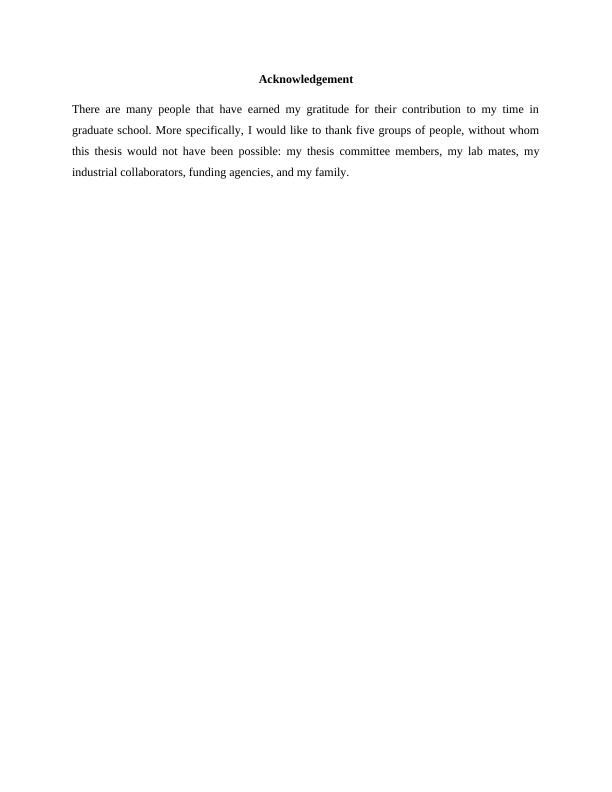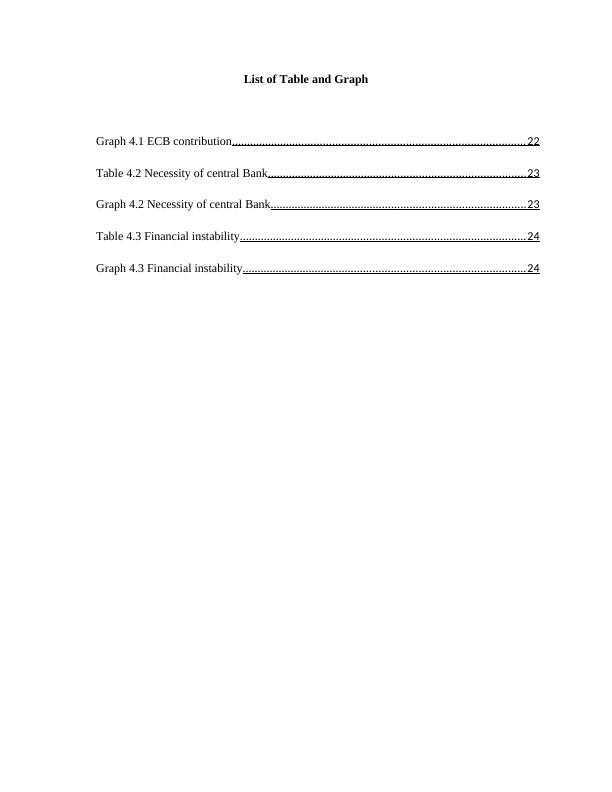Importance of Trust and Confidence in Central Banks for Effective Monetary Policy
Added on 2023-05-30
34 Pages9081 Words329 Views
TRUST AND CONFIDENCE IN CENTRAL BANKS IS CRUCIAL
FOR THE EFFECTIVENESS OF MONETARY POLICY
FOR THE EFFECTIVENESS OF MONETARY POLICY

Executive Summary
Trust and Confidence in central banks is crucial for the effectiveness of monetary policy.
Therefore, the central banks across the globe is supposed to make sure that they implement
monetary tools that it is using are both transparent and widely accepted by players within the
financial market. The central bank is responsible for maintaining stability within the financial
market. It is supposed to put in place measures that can keep the interest rates low.
Trust and Confidence in central banks is crucial for the effectiveness of monetary policy.
Therefore, the central banks across the globe is supposed to make sure that they implement
monetary tools that it is using are both transparent and widely accepted by players within the
financial market. The central bank is responsible for maintaining stability within the financial
market. It is supposed to put in place measures that can keep the interest rates low.

Acknowledgement
There are many people that have earned my gratitude for their contribution to my time in
graduate school. More specifically, I would like to thank five groups of people, without whom
this thesis would not have been possible: my thesis committee members, my lab mates, my
industrial collaborators, funding agencies, and my family.
There are many people that have earned my gratitude for their contribution to my time in
graduate school. More specifically, I would like to thank five groups of people, without whom
this thesis would not have been possible: my thesis committee members, my lab mates, my
industrial collaborators, funding agencies, and my family.

Table of Contents
1.1 Introduction................................................................................................................................6
1.2 Background of the Problem.......................................................................................................7
1.3 Research Rationale:...................................................................................................................7
1.4 Aim and objectives:...................................................................................................................8
1.5 Research Questions....................................................................................................................8
1.6 Limitations of the Research.......................................................................................................9
1.7 Summary....................................................................................................................................9
Chapter 2: Literature Review.........................................................................................................10
2.1 Introduction..............................................................................................................................10
2.2 Trust and Confidence in central banks is crucial for the effectiveness of monetary policy....10
2.3 Research Gap:..........................................................................................................................16
2.4 Summary:.................................................................................................................................16
Chapter3: Research Methodology.................................................................................................17
3.1 Introduction:............................................................................................................................17
3.2 Research philosophy:...............................................................................................................17
3.4 Methods:..................................................................................................................................18
3.5 Data collection process:...........................................................................................................19
3.6 Data analysis process:..............................................................................................................19
3.7 Summary..................................................................................................................................20
1.1 Introduction................................................................................................................................6
1.2 Background of the Problem.......................................................................................................7
1.3 Research Rationale:...................................................................................................................7
1.4 Aim and objectives:...................................................................................................................8
1.5 Research Questions....................................................................................................................8
1.6 Limitations of the Research.......................................................................................................9
1.7 Summary....................................................................................................................................9
Chapter 2: Literature Review.........................................................................................................10
2.1 Introduction..............................................................................................................................10
2.2 Trust and Confidence in central banks is crucial for the effectiveness of monetary policy....10
2.3 Research Gap:..........................................................................................................................16
2.4 Summary:.................................................................................................................................16
Chapter3: Research Methodology.................................................................................................17
3.1 Introduction:............................................................................................................................17
3.2 Research philosophy:...............................................................................................................17
3.4 Methods:..................................................................................................................................18
3.5 Data collection process:...........................................................................................................19
3.6 Data analysis process:..............................................................................................................19
3.7 Summary..................................................................................................................................20

Chapter 4: Findings and discussion...............................................................................................21
4.1 Introduction..............................................................................................................................21
4.2 Quantitative analysis:...............................................................................................................21
4.3 Qualitative analysis:.................................................................................................................24
4.4 Summary..................................................................................................................................25
Chapter 5: Conclusion and Recommendation...............................................................................26
5.1 Conclusion...............................................................................................................................26
5.2 Linking to objective.................................................................................................................26
Objective 1:................................................................................................................................26
Objective 2:................................................................................................................................27
Objective 3:................................................................................................................................27
Objective 4:................................................................................................................................27
5.3 Scope of the research:..............................................................................................................28
5.4 Recommendation.....................................................................................................................28
References:....................................................................................................................................30
4.1 Introduction..............................................................................................................................21
4.2 Quantitative analysis:...............................................................................................................21
4.3 Qualitative analysis:.................................................................................................................24
4.4 Summary..................................................................................................................................25
Chapter 5: Conclusion and Recommendation...............................................................................26
5.1 Conclusion...............................................................................................................................26
5.2 Linking to objective.................................................................................................................26
Objective 1:................................................................................................................................26
Objective 2:................................................................................................................................27
Objective 3:................................................................................................................................27
Objective 4:................................................................................................................................27
5.3 Scope of the research:..............................................................................................................28
5.4 Recommendation.....................................................................................................................28
References:....................................................................................................................................30

List of Table and Graph
Graph 4.1 ECB contribution................................................................................................22
Table 4.2 Necessity of central Bank.....................................................................................23
Graph 4.2 Necessity of central Bank....................................................................................23
Table 4.3 Financial instability..............................................................................................24
Graph 4.3 Financial instability.............................................................................................24
Graph 4.1 ECB contribution................................................................................................22
Table 4.2 Necessity of central Bank.....................................................................................23
Graph 4.2 Necessity of central Bank....................................................................................23
Table 4.3 Financial instability..............................................................................................24
Graph 4.3 Financial instability.............................................................................................24

Chapter 1: Introduction
1.1 Introduction
Trust and Confidence in central banks is crucial for the effectiveness of monetary policy. All
players within the financial sector of a country look to the Central Bank. It is the backbone of the
country's financial sector. If it happens to be lagging behind in the fulfilment of its objectives,
the country's financial sector would crumble.
The central bank is the main bank of a country. It is responsible for managing money supply,
interest rates, and inflation rates. There are five major objectives of the main bank of a county.
First of all, it is responsible for putting in place measures that can lead to a low inflation rate.
According to Bauer and Becker (2014, p.88), it is the goal of the bank to try by all means to keep
the inflation rate within tolerable limits. Apart from this, the bank is also responsible for
promoting stability within the financial market of a country.
This involves monitoring and managing the conduct of financial market players. It also plays a
huge role in keeping interest rates within reasonable limits. It is the goal of the bank to ensure
that the country's interest rates are good enough to promote economic growth and stability of the
financial market. The exchange rates of the country are also under the control of the central bank.
In order to be successful in as far as carrying out the responsibilities indicated above are
concerned, there is need for the bank to structure a monetary policy that is good enough to
address the issues affecting a country's financial market. Members of the bank use various
financial and economic performance indicators to come up with a monetary policy that is viable
for achieving its objectives (Caprio and Klingebiel, 2012, p.79). They have people working on
the ground and collecting data that is meant for use in the structuring of a monetary policy.
Future projections are made based on the information presented in the data.
But, financial market players including money lending institutions and banks have to put their
trust in the central bank. Otherwise, central bank's monetary policy would not be effective.
Suppose the trust and confidence in the bank is not there, what would happen? Such a situation
would lead to a financial crisis. Lack of trust in the central bank is often as a result of poor or
substandard monetary policy measures. This research critically analyses the impact that the
1.1 Introduction
Trust and Confidence in central banks is crucial for the effectiveness of monetary policy. All
players within the financial sector of a country look to the Central Bank. It is the backbone of the
country's financial sector. If it happens to be lagging behind in the fulfilment of its objectives,
the country's financial sector would crumble.
The central bank is the main bank of a country. It is responsible for managing money supply,
interest rates, and inflation rates. There are five major objectives of the main bank of a county.
First of all, it is responsible for putting in place measures that can lead to a low inflation rate.
According to Bauer and Becker (2014, p.88), it is the goal of the bank to try by all means to keep
the inflation rate within tolerable limits. Apart from this, the bank is also responsible for
promoting stability within the financial market of a country.
This involves monitoring and managing the conduct of financial market players. It also plays a
huge role in keeping interest rates within reasonable limits. It is the goal of the bank to ensure
that the country's interest rates are good enough to promote economic growth and stability of the
financial market. The exchange rates of the country are also under the control of the central bank.
In order to be successful in as far as carrying out the responsibilities indicated above are
concerned, there is need for the bank to structure a monetary policy that is good enough to
address the issues affecting a country's financial market. Members of the bank use various
financial and economic performance indicators to come up with a monetary policy that is viable
for achieving its objectives (Caprio and Klingebiel, 2012, p.79). They have people working on
the ground and collecting data that is meant for use in the structuring of a monetary policy.
Future projections are made based on the information presented in the data.
But, financial market players including money lending institutions and banks have to put their
trust in the central bank. Otherwise, central bank's monetary policy would not be effective.
Suppose the trust and confidence in the bank is not there, what would happen? Such a situation
would lead to a financial crisis. Lack of trust in the central bank is often as a result of poor or
substandard monetary policy measures. This research critically analyses the impact that the

financial crisis and the non-standard monetary policy tools (e.g. quantitative easing) influenced
the level of trust in the European Central Bank (ECB). It focuses on information highlighted in
appropriate literature that discusses the level of trust in the ECB as a result of the effects of
financial crisis and the non-standard monetary policy tools. The ECB is a central bank of the
European Commission and therefore plays the role of a central bank of any country or regional
community (Diaz-Alejandro, 2015, p.124). It is responsible for the administration of monetary
policy of one of the largest market and financial areas on earth. Like any other central bank, it is
required to formulate a monetary policy that achieves all its major objectives for the good of the
Euro Zone and its partners. Members of the Euro Zone's financial market are supposed to have
trust in its monetary policy for it to be a success.
1.2 Background of the Problem
The financial crisis which started in the year 2007 had a significant impact on the economy of
the entire globe. Even though it started in the U.S., it spread to all countries around the world.
Europe was equally badly hit by the crisis. The consequences of the financial crisis ranges from
job losses, skyrocketing interest rates, collapsing companies, low consumer spending, stagnation
in economic growth, and lack of confidence in the government. Many countries across the globe
including Europe in particular resorted to the implementation of austerity measures. In response,
central banks around the world came up with a number of rigorous measures for purposes of
containing the effects of the crisis. Europe in particular, had taken a good number of steps
centred on stimulating economic growth (Ehrmann, et al. 2013, p.52). The ECB was at the helm
of enforcing specific monetary measures to address the impacts of the crisis. But, some of the
monetary tools that the bank had employed were actually substandard. For example, they used
the quantitative easing method which was aimed at lowering interest rates by buying out
financial market assets. Although this increased money supply in the European economy, it made
it hard for other market players to benefit from an increase in the availability of funds.
1.3 Research Rationale:
The main problem in this case is to points out the role of the central banks during the financial
crisis and according to Blinder, economic management is an important thing in order to
understand the monetary policy and expectance of the public on the bank denotes the trust of the
the level of trust in the European Central Bank (ECB). It focuses on information highlighted in
appropriate literature that discusses the level of trust in the ECB as a result of the effects of
financial crisis and the non-standard monetary policy tools. The ECB is a central bank of the
European Commission and therefore plays the role of a central bank of any country or regional
community (Diaz-Alejandro, 2015, p.124). It is responsible for the administration of monetary
policy of one of the largest market and financial areas on earth. Like any other central bank, it is
required to formulate a monetary policy that achieves all its major objectives for the good of the
Euro Zone and its partners. Members of the Euro Zone's financial market are supposed to have
trust in its monetary policy for it to be a success.
1.2 Background of the Problem
The financial crisis which started in the year 2007 had a significant impact on the economy of
the entire globe. Even though it started in the U.S., it spread to all countries around the world.
Europe was equally badly hit by the crisis. The consequences of the financial crisis ranges from
job losses, skyrocketing interest rates, collapsing companies, low consumer spending, stagnation
in economic growth, and lack of confidence in the government. Many countries across the globe
including Europe in particular resorted to the implementation of austerity measures. In response,
central banks around the world came up with a number of rigorous measures for purposes of
containing the effects of the crisis. Europe in particular, had taken a good number of steps
centred on stimulating economic growth (Ehrmann, et al. 2013, p.52). The ECB was at the helm
of enforcing specific monetary measures to address the impacts of the crisis. But, some of the
monetary tools that the bank had employed were actually substandard. For example, they used
the quantitative easing method which was aimed at lowering interest rates by buying out
financial market assets. Although this increased money supply in the European economy, it made
it hard for other market players to benefit from an increase in the availability of funds.
1.3 Research Rationale:
The main problem in this case is to points out the role of the central banks during the financial
crisis and according to Blinder, economic management is an important thing in order to
understand the monetary policy and expectance of the public on the bank denotes the trust of the

End of preview
Want to access all the pages? Upload your documents or become a member.
Related Documents
Effects of Central Bank Independence on Inflation Ratelg...
|118
|25051
|252
Impact of macroeconomic determinants on interest rate PDFlg...
|52
|13302
|378
A Critical Review and Assessment of the Role of Corporate Governance in Credit Unions Globallylg...
|57
|16451
|62
Cryptocurrencies and their IMPACTS ON MONETARY POLICYlg...
|34
|13984
|205
Impact of the Recession | Dissertationlg...
|72
|21254
|272
Factors Affecting Online Shopping of Thai Students at University of Northamptonlg...
|52
|12514
|107
